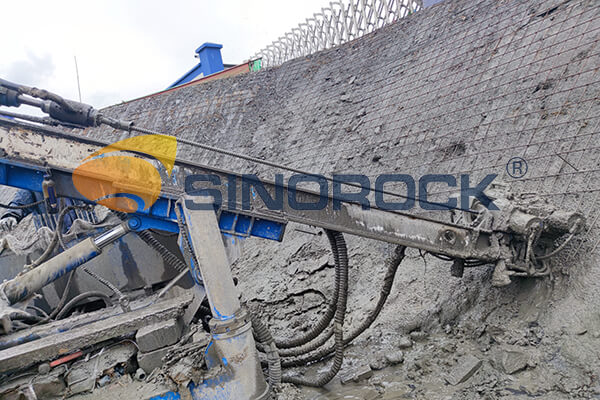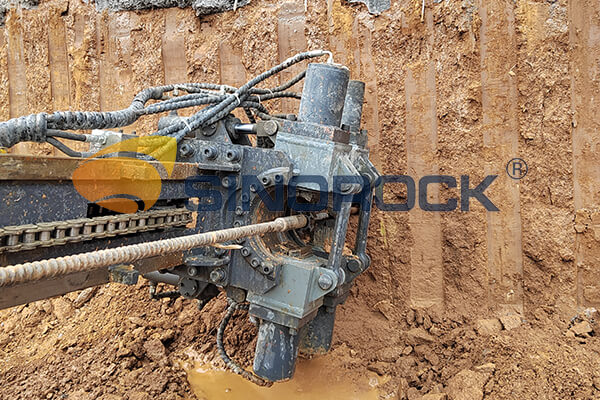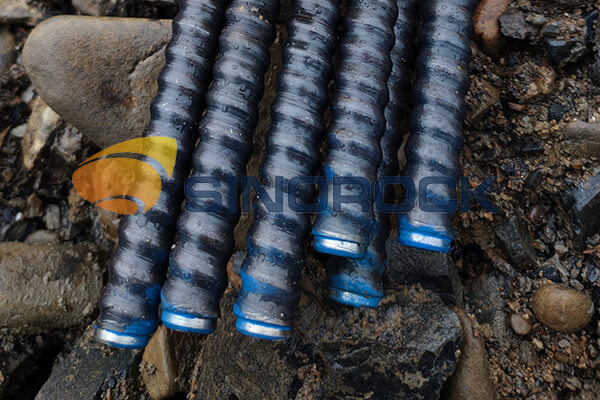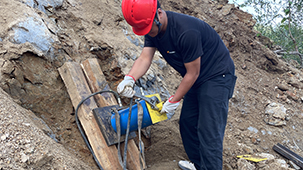Application of Self-Drilling Rock Anchor Bolts in Deep Foundation
Time:2025-10-10From:sinorock View:
As the global economy expands, the demand for underground space utilization continues to grow. The complexity and depth of deep foundation pit projects are increasing as urbanization and infrastructure development accelerate. Consequently, the need for effective and reliable foundation pit support technologies has become paramount. Among the various support methods that have evolved, the pile-anchor support system remains one of the most widely adopted. Traditional prestressed bolts have served as a cornerstone in this system, offering mature and cost-effective technology. However, challenges such as difficult geological conditions have led to the rise of innovative solutions, with self-drilling rock anchor bolts emerging as a preferred option in many deep foundation applications.

Challenges in Deep Foundation Construction
One of the primary challenges in deep foundation construction lies in the complexity of geological conditions. Deep foundation pits are often located in areas with unstable ground, such as gravel fill, soft soils, and broken rock formations. In these environments, traditional prestressed anchor bolts face numerous limitations. Collapse of drill holes, necking of the bolts, insufficient bolt length, and poor grouting effects are common problems encountered during construction, making it difficult to ensure structural stability. These issues not only slow down the progress of construction but can also compromise the safety and integrity of the supporting structures.
A significant example of these challenges can be observed in a deep foundation pit project where the internal prestressed anchor rods experienced severe hole collapse. During the drilling process, the rods became stuck or drilling could not proceed, resulting in the failure to meet the design requirements for anchor rod length. Even when casing pipes were used to stabilize the drill holes, the drilling process remained slow, and upon removal of the casing, the holes collapsed again, blocking the grouting channels. These construction difficulties led to the adoption of self-drilling rock anchor bolt technology as a solution to ensure the successful completion of the project.
Introduction to Self-Drilling Rock Anchor Bolts
Self-drilling rock anchor bolts represent a modern, versatile solution designed to address the challenges posed by complex ground conditions. Unlike traditional anchor bolts, SDRAB systems integrate the functions of drilling, grouting, and anchoring into a single process. This integration streamlines construction, reduces the risk of hole collapse, and improves overall project efficiency.

Components of Self-Drilling Rock Anchor Bolts
A self-drilling rock anchor bolt system typically consists of the following components:
1. Sacrificial drill bit: This bit is attached to the leading end of the hollow bolt and is designed to break through the rock or soil during drilling.
2. Hollow threaded bar: The hollow bar serves as both the drill rod and the anchor body. It allows for grouting to be conducted through the center of the bar after drilling.
3. Coupler: This component is used to connect additional sections of hollow bars when longer bolts are needed for deeper foundations.
4. Plate and nut: These components provide surface support and ensure the tensioned anchor rod remains in place.
5. Grouting: Grouting fills the hollow space inside the bar and any voids in the surrounding ground, improving the strength and stability of the structure.
By combining these elements, self-drilling anchor bolts offer a reliable and efficient solution for deep foundation pit support.

Construction Process of Self-Drilling Rock Anchor Bolts
The construction process of self-drilling rock anchor bolts is relatively straightforward, yet effective. It comprises several key steps that ensure precision, strength, and stability in challenging geological environments.
1. Layout and Positioning
Before construction begins, precise positioning of the anchor rods is essential. The design specifications for vertical and horizontal spacing are marked on-site to ensure that the anchor rods are properly aligned for optimal support.
2. Installation of Drill Pipe and Drill Bit
Typically, a rock bolt drilling machine, such as the KW180 series, is used for installation. The hollow anchor rod itself serves as the drill pipe, with an alloy drill bit attached to its leading end. This bit is designed to break through various types of rock and soil while allowing grouting to occur through small holes in the bit.
3. Drilling
Once the equipment is set up and aligned according to the pre-marked layout, drilling begins. It is crucial to maintain the correct drilling angle and depth to meet the design specifications. Surveyors play a critical role in ensuring the accuracy of this phase by staking out the anchor rod’s position and verifying the rig’s alignment.
4. Extending the Hollow Bar
For deeper foundation pits, additional sections of hollow bars may need to be connected to reach the required depth. This is done using couplers, which link multiple sections of the anchor rod together. In cases where the anchor rod will extend through free sections of soil, a protective PVC corrugated pipe may be placed around the rod to prevent corrosion or damage to the bar during grouting and tensioning.
5. Grouting
Grouting is a crucial step that fills any voids around the anchor rod and improves the bond between the rod and surrounding soil or rock. A pure cement slurry is typically used for grouting, ensuring even distribution and preventing the formation of air pockets or weak spots. High-pressure grouting equipment is used to inject the slurry into the hollow bar, filling the surrounding area. Grouting pressures are maintained at a minimum of 1.5 MPa to ensure that the slurry reaches all gaps and cracks in the surrounding formation, thus improving the overall strength of the anchoring system.
6. Tensioning and Locking
After the grout has set and reached the desired strength, the final step is tensioning and locking the anchor rod. This involves applying a controlled amount of tension to the rod using specialized equipment, followed by the addition of a support plate and locking nut to ensure the system remains secure. The tensioning process further increases the bond between the anchor rod and surrounding material, contributing to the overall stability of the foundation pit.
Advantages of Self-Drilling Rock Anchor Bolts in Deep Foundations
The growing adoption of self-drilling rock anchor bolts in deep foundation construction can be attributed to several distinct advantages. These benefits make them particularly suitable for projects involving challenging geological conditions, such as deep gravel fills, broken rock, or soft soils.
1. Combination of Drilling, Grouting, and Anchoring
Perhaps the most significant advantage of self-drilling rock anchor bolt systems is the integration of drilling, grouting, and anchoring into a single operation. This feature eliminates the need for multiple steps and equipment, reducing both time and labor costs. Traditional anchor systems often require casing pipes to stabilize drill holes, especially in soft or collapsing soils. By contrast, self-drilling bolts act as both the drill rod and anchor, eliminating the need for separate casing pipes and significantly improving efficiency.
2. Versatility in Difficult Ground Conditions
Self-drilling anchor bolts are particularly well-suited for use in complex geological conditions where traditional methods struggle. These conditions include:
- Collapsing soils: Self-drilling rock anchor bolts are designed to prevent hole collapse by immediately reinforcing the surrounding material with grout after drilling.
- Broken rock formations: The ability to select from a variety of drill bit designs allows for customized solutions based on the specific rock or soil type.
- Soft soils: Traditional bolts often struggle to achieve proper bonding in soft soils. The pressure grouting used in SDRAB systems ensures a secure bond between the anchor and the surrounding material, even in difficult soils.
3. Enhanced Grouting Efficiency
The hollow bar design of self-drilling anchor bolts allows for efficient pressure grouting. This technique ensures that grout fills any cracks, voids, or gaps in the surrounding material, significantly improving the anchoring system's overall strength. Pressure grouting also reduces the risk of water ingress, further stabilizing the foundation pit and preventing long-term erosion or settlement issues.
4. Flexibility in Length and Configuration
One of the standout features of self-drilling rock anchor bolt systems is their flexibility in terms of length and configuration. The hollow bars can be easily extended using couplers, allowing for the installation of longer anchor rods when required. Additionally, the bars can be cut to size on-site, ensuring that they can fit into even the most confined spaces. This versatility is especially valuable in urban construction projects where access is limited, and large equipment may not be able to enter the site.
5. Reduced Material Waste and Environmental Impact
Because self-drilling anchor bolts eliminate the need for separate casing pipes, there is less material waste generated during the construction process. The grouting process also uses materials more efficiently, reducing the overall environmental impact of the project. Additionally, the ability to complete construction more quickly with fewer materials helps minimize the project’s carbon footprint, contributing to more sustainable construction practices.
Conclusion
The application of self-drilling rock anchor bolts in deep foundation construction represents a significant advancement in geotechnical engineering. With their ability to integrate drilling, grouting, and anchoring into a single, efficient process, self-drilling rock anchor bolt systems offer numerous advantages over traditional methods. These systems excel in challenging geological conditions, providing reliable, cost-effective, and environmentally friendly solutions for deep foundation pit support. As the construction industry continues to evolve and demand for underground space increases, self-drilling anchor bolt technology is poised to play an increasingly important role in ensuring the safety and stability of future infrastructure projects.
latest news
-
.jpg)
- Common Failures For Hollow Anchor Bar Tunnel Construction
- Time:2025-10-28From:This Site
- Common failures in hollow anchor bar tunnel construction: causes, solutions, and Sinorock’s self-drilling bolt technology for safer tunnels.
- View details
-

- Top 6 Critical Steps for Self-Drilling Anchor Bolt Construction
- Time:2025-10-23From:This Site
- Master the 6 critical steps for self-drilling anchor installation! Boost construction safety and efficiency with expert grouting and drilling tips.
- View details
-

- What Factors Affect the Tensile Strength of Self-Drilling Anchor Bolts?
- Time:2025-10-16From:This Site
- Discover the key factors affecting the tensile strength of self-drilling anchor bolts: diameter, length, shear strength, grouting pressure, and wall thickness. Learn how to optimize for safer tunneling and slope projects!
- View details
-

- Sinorock 2025 Quality Month | Strengthening Quality Foundations, Empowering Product Excellence
- Time:2025-08-13From:This Site
- Sinorock’s 2025 Quality Month, themed “Strengthening Quality Foundations, Empowering Product Excellence,” successfully concluded, reinforcing our commitment to superior product quality.
- View details
-

- Sinorock Safety Month 2025 | Everyone Speaks Safety, Everyone Can Respond
- Time:2025-07-03From:This Site
- Sinorock Safety Month 2025, centered on the theme "Everyone Speaks Safety, Everyone Can Respond - Spot Workplace Hazards," has wrapped up successfully!
- View details
-

- Quality Control: the Vital Factor of A SDA Bolt Factory
- Time:2025-01-09From:This Site
- Sinorock’s comprehensive quality control system, from supplier management to outgoing inspections, ensuring the highest standards for self-drilling anchor bolts in construction.
- View details
-

- SINOROCK to Showcase Innovative Mining Solutions at Mining and Metals Central Asia 2025
- Time:2025-09-09From:This Site
- We are pleased to share that SINOROCK will participate in the Mining and Metals Central Asia 2025, taking place from September 17 to 19 at the Atakent International Exhibition Centre in Almaty, Kazakhstan. You can find us at Booth 11-231.
- View details
-

- Sinorock Invites You to Explore Proven Self-Drilling Anchor Bolt Solutions at bauma 2025
- Time:2025-03-07From:This Site
- From April 7–13, 2025, explore Sinorock’s Self-drilling anchor bolt solution at Booth C2.513/4 in Hall C2 of the Messe München Exhibition Center (Munich, Germany).
- View details
-
.jpg)
- SINOROCK to Attend EXPOMINA PERÚ 2024 in Lima, Peru
- Time:2024-08-10From:This Site
- Sinorock to Attend EXPOMINA PERÚ 2024 in Lima, Peru
- View details
 Download
Download 


